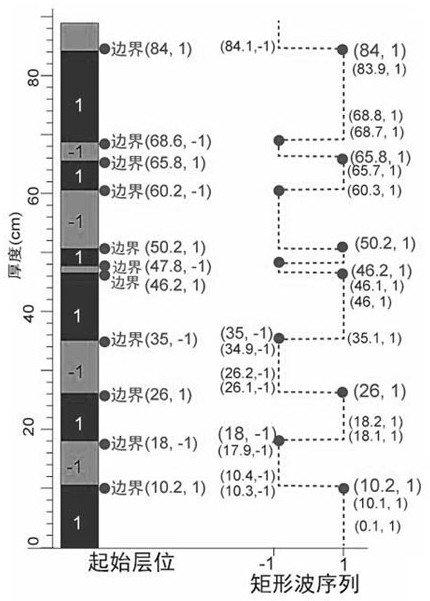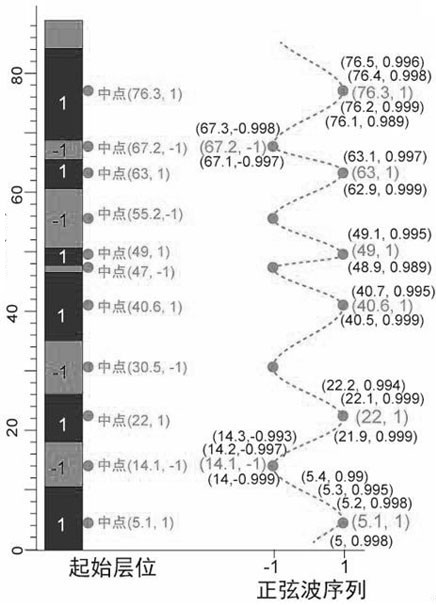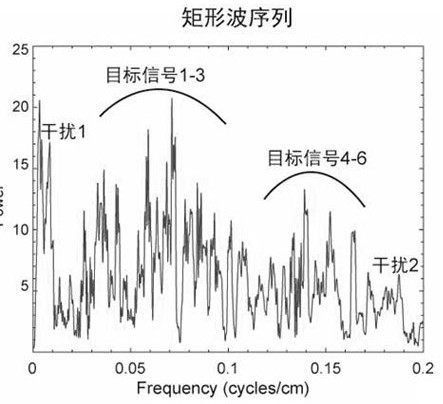Method for analyzing cycle strata based on lithology midpoint sinusoidal interpolation model
An interpolation model and lithology technology, applied in the field of sedimentary stratigraphy, can solve problems such as multi-interference peak spectrum, increase the difficulty of identifying target astronomical signals in the formation, achieve the effect of solving a large number of interference signals and improving the simulation matching effect
- Summary
- Abstract
- Description
- Claims
- Application Information
AI Technical Summary
Problems solved by technology
Method used
Image
Examples
Embodiment 1
[0026] A 1300cm-thick siliceous-shale cycle formation that has been confirmed to contain astronomical signals of slope and precession period was selected, and the SiO 2 The siliceous rock unit with higher content is assigned a value of 1, and the SiO 2 The mudstone unit with low content is assigned a value of -1, and the bottom layer of the cycle strata is taken as the initial horizon, and the middle points of 11 lithological units are selected upwards in turn, and the distance from each middle point to the initial horizon is used as the distance from each middle point to the initial horizon. X coordinate, assign the value of the lithological unit where the middle point is located as the Y coordinate of each middle point, and establish the coordinate points (5.1, 1), (14.1, -1), (22, 1), (30.5, -1) of each middle point ), (40.6, 1), (47, -1), (49, 1), (55.2, -1), (63, 1), (67.2, -1), (76.3, 1); Uniform and uniform interpolation between coordinate points, such as coordinate po...
Embodiment 2
[0031] Select a synthetic slope-precession theoretical model sequence that contains slope and precession period astronomical signals. The theoretical model sequence contains two columns of XY data. The X value of the first column of data is the time from 0 to 3000kyr at an interval of 1kyr. The Y value of the second column of data is the slope-precession change value per 1kyr. The slope-precession value is in Fluctuation changes between -4 and 5; the theoretical model sequence sequence is converted into a ternary cycle sequence, and the steps include: the second column of data Y≤0 is assigned a value of 1, 0f (t)=Acosωt Gradually increase, (Xn, 2), (Xn+0.1, 2+(cos(π*0.1 / 0.1 / N+π)+1) / 2), (Xn+0.2, 2+(cos(π*0.2 / 0.1 / N+π)+1) / 2), (Xn+0.3,2+(cos(π*0.3 / 0.1 / N+π)+1) / 2), ..., (Xm,3), get Such as Figure 8 Shown sine wave sequence, spectrum analysis and Fourier transform analysis are carried out to described sine wave sequence, obtain as Figure 10 The spectrum analysis diagram of the s...
PUM
 Login to View More
Login to View More Abstract
Description
Claims
Application Information
 Login to View More
Login to View More - R&D
- Intellectual Property
- Life Sciences
- Materials
- Tech Scout
- Unparalleled Data Quality
- Higher Quality Content
- 60% Fewer Hallucinations
Browse by: Latest US Patents, China's latest patents, Technical Efficacy Thesaurus, Application Domain, Technology Topic, Popular Technical Reports.
© 2025 PatSnap. All rights reserved.Legal|Privacy policy|Modern Slavery Act Transparency Statement|Sitemap|About US| Contact US: help@patsnap.com



